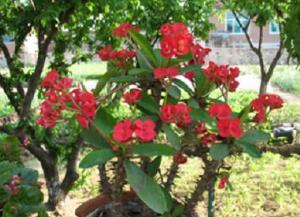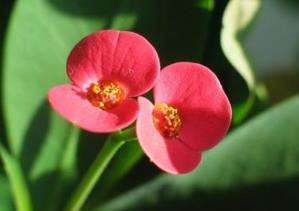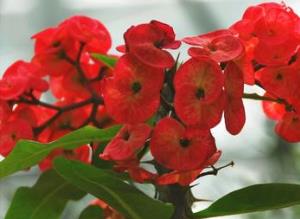The planting method of Prunus mume is it poisonous?
Prunus angustifolia is a popular indoor plant in the market. Because its tiger thorn plum blossoms all the year round, and blossoms the most in winter in the northern hemisphere, it is deeply loved by flower friends, but do you know all about breeding tiger thorn plum? now let me introduce you to the knowledge of breeding.
First, tiger thorn plum

Tiger thorn plum, also known as Kirin flower, iron begonia, leaf cactus, is a succulent plant of Euphorbiaceae, native to Madagascar, Africa, this flower is a horticultural hybrid of unicorn flower. The whole plant of this flower is poisonous, and the white milk is highly toxic; accidental eating will cause vomiting and diarrhea.
Families raise tiger thorns and plums, as long as they do not fold flowers for children to play at will, it will not cause harm. Experienced florists also often use the leachate from the stems and leaves of Euphorbia plants to control aphids, red spiders and other flower pests. Stems, branches and leaves can be used as medicine. Cold in nature, bitter in taste. There is a small poison, it has the effect of eliminating poison and releasing fire, cooling blood and stopping bleeding.
Second, the planting method of Prunus mume.
I. the culture method of tiger thorn plum
Potted soil: the leaves of tiger thorn plum grow upright and upward, and the flowerpot had better choose a deeper tube basin, which will appear compact and beautiful. The soil used for breeding can use two portions of garden soil and two portions of river sand, one part of compost, and a small amount of horseshoe bone powder as base fertilizer.
Temperature: the most suitable temperature for growth is 15 degrees to 32 degrees, more afraid of high temperature and muggy weather, if the summer temperature reaches more than 33 degrees will enter a dormant state. In winter, it is also necessary to strengthen the temperature management of Chimonanthus roxburghii, because when the temperature drops below 4 degrees Celsius, it will enter a dormant period, and when the temperature is close to 0 degrees, it will freeze to death.

Lighting: Chimonanthus przewalskii is suitable for curing in semi-shade, or shading it by 50% in the sun, which is conducive to the growth of its leaves and make its color more beautiful. Direct sunlight can be given in spring and autumn, because the temperature is not very high, keep it in a bright place indoors in winter and control the light in summer.
Fei Shui: the drought tolerance of Prunus angustifolia is very strong, and it is very suitable for growing in a dry environment. Of course, tiger thorn plum still needs to be watered, but its roots are afraid of water stains. If there is water in the flowerpot, or if it is watered and fertilized too frequently, it will easily cause rotting roots.
II. Matters needing attention in breeding tiger prickly plum
You can't put tiger thorn plum outdoors on cloudy and rainy days, for fear of rain and easy to be infected by bacteria. There are few diseases and insect pests, and the common diseases in seedling stage are anthracnose, powdery mildew, scab and so on. The main insect pests are grubs, golden needles and so on. In addition, tiger thorn plum is very easy to breed with cuttings, and can be carried out throughout the growing period. Finally, I would like to say that the tiger thorn plum is a horticultural hybrid of the unicorn flower, the whole flower is poisonous, the white milk is toxic, and there will be vomiting and diarrhea.

Third, the planting mode of tiger thorn plum.
Chimonanthus przewalskii is mainly used for planting and breeding, and the substrate is used for planting nutritious soil or river sand, peat soil and other materials. Due to the limited conditions, it is difficult to get an ideal insertion substrate, so it is recommended to use a prepared and sterilized substrate; medium and coarse river sand is also fine, but rinse with clean water several times before use. Do not use sea sand and river sand in saline-alkali areas, they are not suitable for the growth of flowers and plants. In early spring or late autumn. In the peak growing season, cut the leaves or stems and insert them into the substrate after the wound is dried, and spray the cuttings and substrate slightly. As long as the substrate is not too dry or water-stained, roots and new buds can grow quickly. When the temperature is high from late spring to early autumn, cuttings are very easy to rot, so it is best not to cut them.
On the basin: when the seedlings are installed in the basin, first put a coarse-grained matrix or ceramsite with a thickness of 2 to 2 centimeters at the bottom of the basin as a filter layer, sprinkle a layer of fully mature organic fertilizer as base fertilizer with a thickness of about 1 to 2 centimeters, and then cover it with a substrate, which is about 1 to 2 centimeters thick, and then put in the plant to separate the fertilizer from the root system and avoid burning roots.

Temperature management: the optimum growth temperature is 15 to 32 degrees, afraid of high temperature and muggy heat, and go into dormancy when the summer temperature is above 33 degrees. Avoid cold frost, the overwintering temperature needs to be kept above 10 degrees, and it will also enter a dormant state when the temperature drops below 4 degrees in winter. If the ambient temperature is close to 0 degrees, it will die of frostbite.
1. In summer: strengthen air convection so that the temperature in the body can be released, put it in the semi-shade, or give it shade 50%, spray it properly, 2 to 3 times a day.
2. In winter: move to a brightly lit place to maintain it outdoors, wrap it with a film to survive the winter, but uncover the film every two days when the temperature is high at noon and let it breathe.
Light management: the leaf color will be more beautiful when you keep it in the semi-shade or shade it for 50% in summer. In spring and autumn, because the temperature is not very high, it is necessary to give it direct sunlight to facilitate its photosynthesis to accumulate nutrients. In winter, keep it indoors where there is bright light for maintenance. Usually put in the indoor maintenance, should be placed in the southeast near the doors and windows, in order to receive light, and every month or one and a half months, to move to the outdoor maintenance for two months, otherwise the leaves will grow thin, yellow, new branches or petioles slender, elongated internodes, in a state of overgrowth.

Fertilizer and water management: it has strong drought tolerance and can grow under dry environmental conditions, but this does not mean that it does not water or fertilize it; its roots are afraid of water stains, and if there is water in the flowerpot, or if it is watered and fertilized too frequently, it is easy to cause rotten roots. The principle of watering it is to dry and wet, dry thoroughly, not dry, water thoroughly, and avoid wetting the plant during the day when watering.
Fourth, the use of tiger thorn plum
1. Ornamental value. Tiger thorn plum can be used as pot ornamental, thorn hedge, etc., it is easy to cultivate, long flowering period, red bracts, bright, is a popular potted plant. As the young stem of tiger thorn plum is soft, it is often used to tie peacocks and other shapes, and it has become a boutique in hotels, shopping malls and other public places.
2. Medicinal value. The stems, flower branches and leaves of Prunus mume can be used as medicine. Cool in nature, bitter in taste and slightly poisonous. It has the effect of removing poison and relieving fire, cooling blood and stopping bleeding.
Fifth, is indoor planting tiger thorn plum poisonous?

Euphorbiaceae, Euphorbi This kind of milk is a special structure of diterpenoids, toxic. It is a favorable weapon to protect themselves and prevent diseases and insect pests in the process of plant evolution. Not only that, when the tiger thorn plum blossoms, its flower stalk also secretes glue-like mucus, which can stick to insects, which is also its line of defense to protect itself from insect pests.
There are sharp thorns in the whole plant, and the white milk in the stem is poisonous. The white milk secreted by the wounds of tiger thorn plum plants has a stimulating effect on human skin and mucous membrane, and accidental eating will cause nausea, vomiting, diarrhea, dizziness and so on. Family cultivation will not cause harm as long as it does not fold flowers for children to play at will. Experienced florists also often use the leachate from the stems and leaves of Euphorbia plants to control aphids, red spiders and other flower pests. Stems, branches and leaves can be used as medicine. Cold in nature, bitter in taste. There's a little poison. It has the effect of removing poison and relieving fire, cooling blood and stopping bleeding.
Give flower lovers a piece of advice: although the tiger thorn plum blossom is good, because it is poisonous, it is best not to put it indoors.
If the ambient temperature is close to 0 degrees Celsius, you will die of frostbite.
1. In summer: strengthen air convection so that the temperature in the body can be released, put it in the semi-shade, or give it shade 50%, spray it properly, 2 to 3 times a day.
2. In winter: move to a brightly lit place to maintain it outdoors, wrap it with a film to survive the winter, but uncover the film every two days when the temperature is high at noon and let it breathe.
Light management: the leaf color will be more beautiful when you keep it in the semi-shade or shade it for 50% in summer. In spring and autumn, because the temperature is not very high, it is necessary to give it direct sunlight to facilitate its photosynthesis to accumulate nutrients. In winter, keep it indoors where there is bright light for maintenance. Usually put in the indoor maintenance, should be placed in the southeast near the doors and windows, in order to receive light, and every month or one and a half months, to move to the outdoor maintenance for two months, otherwise the leaves will grow thin, yellow, new branches or petioles slender, elongated internodes, in a state of overgrowth.

Fertilizer and water management: it has strong drought tolerance and can grow under dry environmental conditions, but this does not mean that it does not water or fertilize it; its roots are afraid of water stains, and if there is water in the flowerpot, or if it is watered and fertilized too frequently, it is easy to cause rotten roots. The principle of watering it is to dry and wet, dry thoroughly, not dry, water thoroughly, and avoid wetting the plant during the day when watering.
Fourth, the use of tiger thorn plum
1. Ornamental value. Tiger thorn plum can be used as pot ornamental, thorn hedge, etc., it is easy to cultivate, long flowering period, red bracts, bright, is a popular potted plant. As the young stem of tiger thorn plum is soft, it is often used to tie peacocks and other shapes, and it has become a boutique in hotels, shopping malls and other public places.
2. Medicinal value. The stems, flower branches and leaves of Prunus mume can be used as medicine. Cool in nature, bitter in taste and slightly poisonous. It has the effect of removing poison and relieving fire, cooling blood and stopping bleeding.
Fifth, is indoor planting tiger thorn plum poisonous?

Euphorbiaceae, Euphorbi This kind of milk is a special structure of diterpenoids, toxic. It is a favorable weapon to protect themselves and prevent diseases and insect pests in the process of plant evolution. Not only that, when the tiger thorn plum blossoms, its flower stalk also secretes glue-like mucus, which can stick to insects, which is also its line of defense to protect itself from insect pests.
There are sharp thorns in the whole plant, and the white milk in the stem is poisonous. The white milk secreted by the wounds of tiger thorn plum plants has a stimulating effect on human skin and mucous membrane, and accidental eating will cause nausea, vomiting, diarrhea, dizziness and so on. Family cultivation will not cause harm as long as it does not fold flowers for children to play at will. Experienced florists also often use the leachate from the stems and leaves of Euphorbia plants to control aphids, red spiders and other flower pests. Stems, branches and leaves can be used as medicine. Cold in nature, bitter in taste. There's a little poison. It has the effect of removing poison and relieving fire, cooling blood and stopping bleeding.
Give flower lovers a piece of advice: although the tiger thorn plum blossom is good, because it is poisonous, it is best not to put it indoors.
- Prev

What about the yellow leaves of orchids? what is the reason why the leaves become dry?
What about the yellow leaves of orchids? what is the reason why the leaves become dry?
- Next

Can the fruit of cactus be eaten? The medicinal value of cactus
Can the fruit of cactus be eaten? The medicinal value of cactus
Related
- Wuhan Hospital Iron Tree Blooming Result Was Instantly Frightened by the Gardener Master
- Which variety of camellia is the most fragrant and best? Which one do you like best?
- What is the small blue coat, the breeding methods and matters needing attention of the succulent plant
- Dormancy time and maintenance management of succulent plants during dormancy
- Minas succulent how to raise, Minas succulent plant pictures
- What are the varieties of winter succulent plants
- How to raise succulent plants in twelve rolls? let's take a look at some experience of breeding twelve rolls.
- Attention should be paid to water control for succulent plants during dormant period (winter and summer)
- Watering experience of twelve rolls of succulent plants
- Techniques for fertilizing succulent plants. An article will let you know how to fertilize succulent plants.

